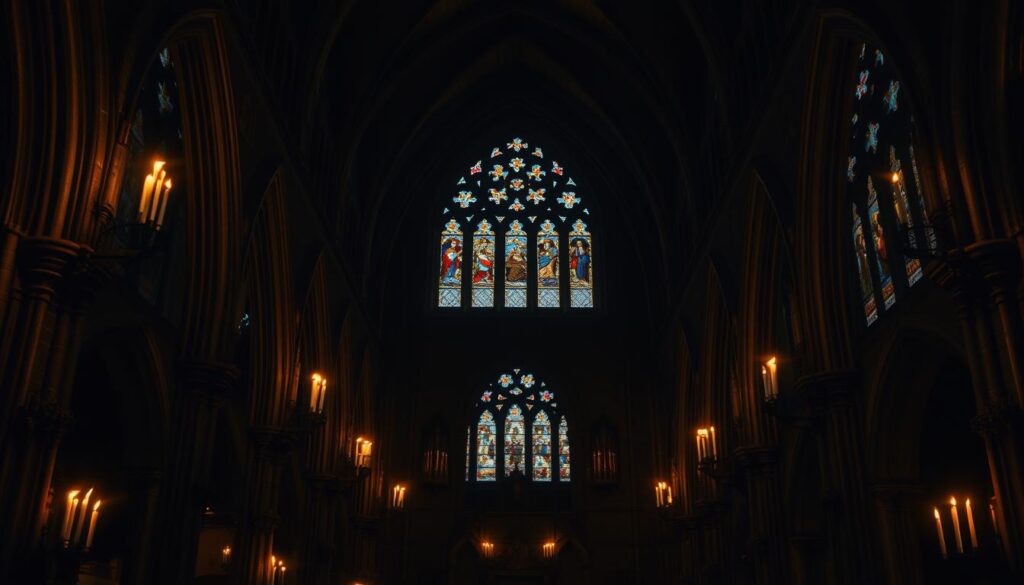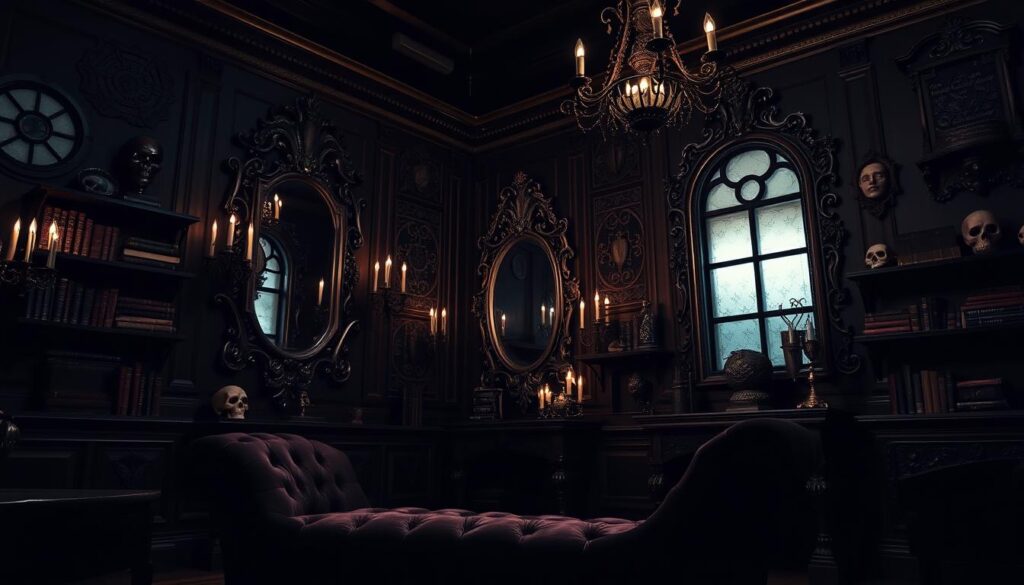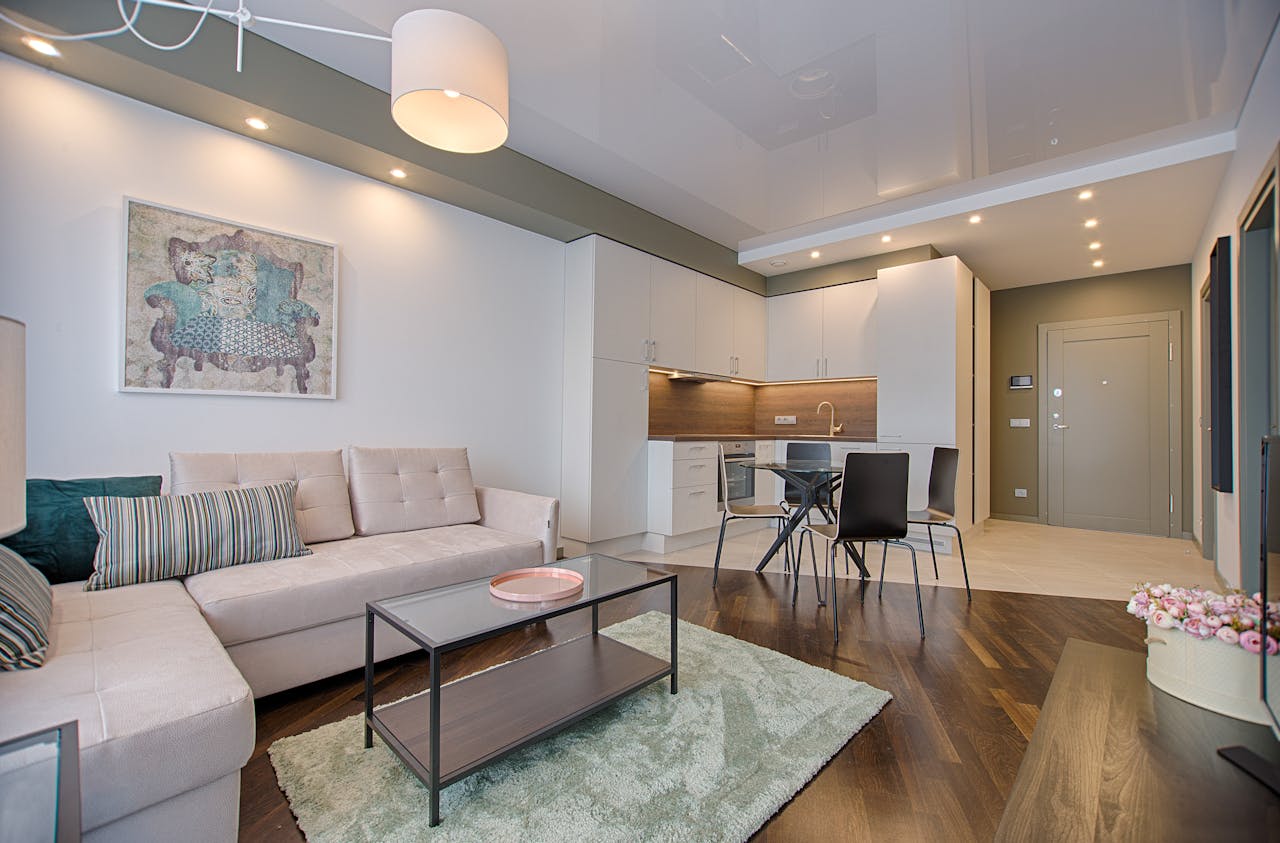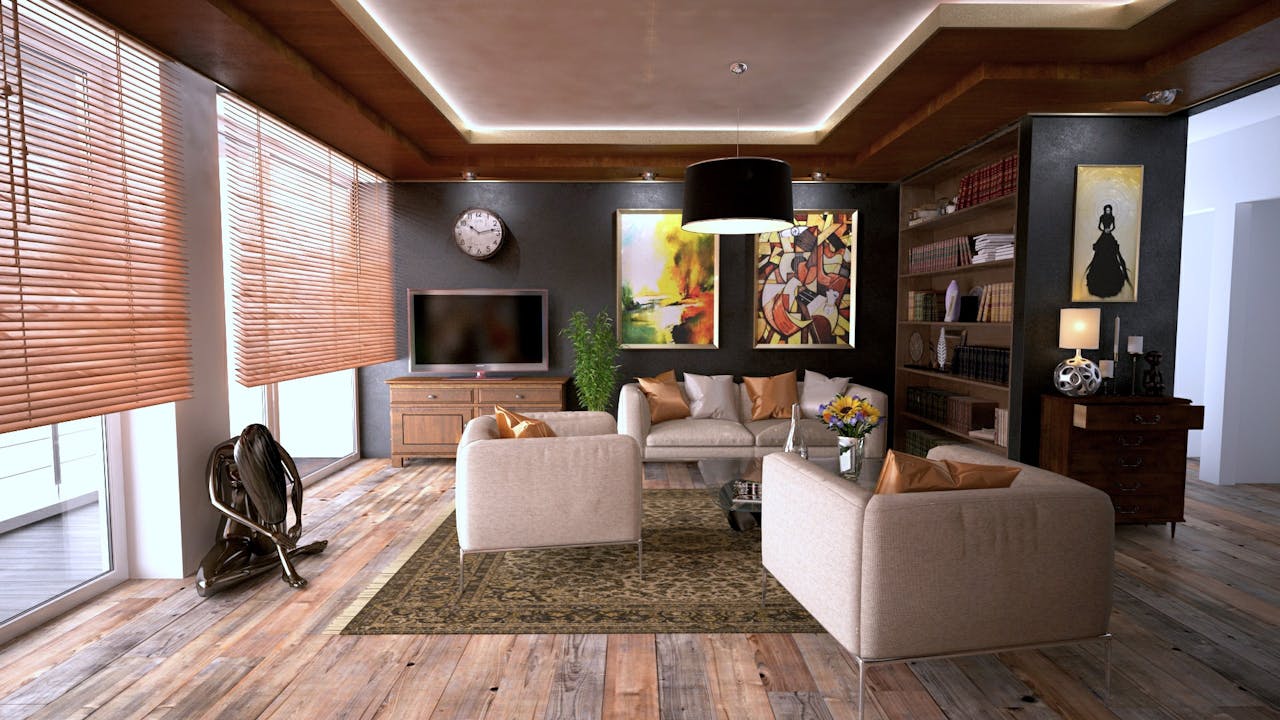The world of Gothic interior style is filled with drama and mystery. It draws inspiration from Europe’s late Middle Ages grand architecture. You’ll find pointed arches, ribbed vaults, and flying buttresses, adding a moody elegance to any room.
Adding Gothic home decor elements can turn your home into a dramatic and welcoming place. It’s ideal for those who love intricate details and the grandeur of historical buildings.
Key Takeaways
- Understand the historical background of Gothic interior design
- Learn how to incorporate Gothic elements into your decor
- Discover the key characteristics of Gothic interior style
- Create a dramatic and inviting space with Gothic home decor
- Transform your home with the elegance of Gothic design
Understanding the Essence of Gothic Design
To truly appreciate Gothic interior style, one must understand its historical context and architectural influences. The Gothic style, which originated in medieval Europe, is known for its dramatic and romantic elements.
Historical Context of Gothic Design
The Victorian Gothic style emerged in the 19th century in England. It combines medieval architecture, Romanticism, and 19th-century literary themes. This creates a unique aesthetic that fills any room with drama.
Gothic Revival was more than just an architectural movement. It was a cultural phenomenon that influenced art, literature, and interior design. The style is marked by its use of pointed arches, ribbed vaults, and intricate stone carvings. These elements were revived and reinterpreted in the 19th century.
Key Characteristics of Gothic Aesthetics
Gothic aesthetics are known for their dark, mysterious, and romantic qualities. They use rich, dark colors, intricate patterns, and ornate furnishings. The style often includes nature-inspired motifs, like foliage and floral patterns, in its decorations.
- Rich, dark color palettes
- Intricate patterns and textures
- Ornate furnishings and decor
- Nature-inspired motifs
By understanding these historical and aesthetic elements, we can better appreciate how Gothic design influences modern interior styles. It creates a dark home aesthetic that is both captivating and unique.
Color Palette in Gothic Interiors
In Gothic interior design, colors are more than just looks. They create an experience that wraps around you. The right colors take you to a world of mystery and luxury, typical of the Gothic style.
Dark and Rich Colors
The gothic color scheme focuses on deep, rich colors. Burgundy, emerald green, midnight blue, and black are key. They make our spaces feel dramatic and moody. These colors are not just pretty; they also set the mood, making our spaces cozy yet mysterious.
Accents and Contrast
Dark and rich colors are the base of Gothic interiors. But accents and contrast really make them pop. Metallic accents like gold or silver add luxury. Contrasting colors add visual interest and depth.
When picking colors for rooms, think about the room’s purpose. For example, a bedroom might need softer, darker hues for relaxation. A living room could use bolder colors to spark conversation.
Furniture Selection for Gothic Interiors
Furniture is key in Gothic design, focusing on dark woods, ornate carvings, and plush upholstery. We’ll look at how to pick the right pieces for a cozy and inviting space.
Gothic furniture stands out with dark, rich woods and detailed designs. It often has ornate carvings and deep, bold colors. Adding antique mirrors and ornate tables can bring light and improve a room’s feel.
When picking furniture for a Gothic home, mix vintage, antique, and modern pieces. Vintage and antique furniture bring authenticity and charm. Modern Gothic furniture gives a new spin on classic designs.
Here are some key elements to look for in Gothic furniture:
- Dark wood finishes, such as mahogany or ebony
- Ornate carvings and intricate details
- Plush upholstery in deep, rich colors like red, purple, or black
- Antique or antique-inspired pieces, such as mirrors and tables
To show what Gothic furniture looks like, let’s look at a table:
| Furniture Piece | Characteristics | Example |
|---|---|---|
| Armchair | Dark wood, ornate carvings, plush upholstery | A Victorian-era armchair with intricate carvings and red velvet upholstery |
| Coffee Table | Dark wood, ornate legs, Gothic-inspired design | A wooden coffee table with carved Gothic arches |
| Mirror | Ornate frame, antique or antique-inspired | An antique mirror with a gilded, ornate frame |
By using these elements and pieces, you can make a Gothic interior that’s both mysterious and welcoming. It’s good to mix dark, rich furniture with lighter accents to keep the space balanced.
Lighting Choices in Gothic Design
In Gothic design, lighting is more than just a need; it’s a form of art. The right lighting can transform a space into a mysterious and elegant haven.
Lighting fixtures in Gothic interiors are not just for function. They are also decorative pieces that add to the space’s beauty. Let’s look at some key lighting choices for the perfect Gothic ambiance.
Chandeliers and Candelabras
Chandeliers and candelabras are key in Gothic lighting. They bring elegance and sophistication, and also provide enough light. Ornate chandeliers with detailed designs can be a room’s centerpiece, drawing the eye upwards and adding grandeur.
- Candelabras offer a warm and intimate lighting, great for cozy spots.
- Choose candelabras with dramatic designs and many arms for a Gothic feel.

Ambient and Task Lighting
Ambient lighting sets the mood of a space, while task lighting focuses on specific tasks. In Gothic interiors, ambient lighting is key for a mysterious and welcoming atmosphere.
- Use dimmer switches to adjust the ambient lighting, changing the space’s mood.
- For task lighting, pick table lamps or floor lamps with Gothic designs to enhance the aesthetic.
By mixing different lighting types, like chandeliers, candelabras, ambient, and task lighting, you can create a rich and layered lighting scheme. This will enhance the Gothic feel of your space.
Textiles and Patterns in Gothic Decor
Gothic decor uses textiles to create a dramatic and luxurious feel. These textiles add depth, texture, and complexity to a room. This makes the space feel more inviting and richly decorated.
Fabrics and Upholstery
The choice of fabrics and upholstery is key in Gothic decor. Heavy velvet drapes, elaborate lace, and rich fabrics are essential. These materials add luxury and create a sense of grandeur.
Choose fabrics with a heavy, rich texture. Velvet, silk, and heavy cotton are great options. For upholstery, look for pieces with intricate carvings or ornate details that match the Gothic style.
Patterns that Enhance Gothic Themes
Patterns are vital in Gothic decor. Traditional Gothic patterns include intricate florals, damask, and Gothic arches. These patterns can be used in various decor elements, like wallpaper and upholstery.
To achieve a cohesive look, mix different patterns. For example, pair a bold, Gothic-inspired print with a more subtle, textured fabric. This adds visual interest and depth to a room.
| Pattern Type | Description | Usage |
|---|---|---|
| Gothic Arches | Intricate patterns featuring Gothic arches | Wallpaper, Upholstery |
| Damask | Reversible patterned fabric with a woven design | Drapes, Upholstery |
| Intricate Florals | Detailed floral patterns with a Gothic twist | Wallpaper, Fabrics |
By choosing the right textiles and patterns, you can create a Gothic-inspired space. It can be both dramatic and inviting. Whether you want to add luxury or make a bold statement, the right choices can make a big difference.
Incorporating Artwork and Accessories
Artwork and accessories are key to a Gothic-inspired home’s character. They add to the mystique and elegance of Gothic design. By choosing them wisely, we can make our home feel more Gothic.

Gothic Art Styles
Gothic art often has mystical, medieval, and religious themes. Adding artwork that matches these themes can really bring out the Gothic feel. Look for pieces with intricate details and dramatic imagery, like stained glass or medieval tapestries.
For more Gothic art, check out artists who focus on Gothic themes. You’ll find inspiration in paintings and sculptures that fit the Gothic style. For more tips on Gothic decor, see Architectural Digest’s guide.
Decorative Elements and Accessories
Decor items like candelabras, gargoyle sculptures, and old books add mystery to Gothic interiors. They show the style’s historical side and create a unique atmosphere. Choose items that show grandeur and mysticism.
- Candelabras and chandeliers with detailed metalwork bring medieval elegance.
- Gargoyle sculptures and stone carvings are unique decorative pieces.
- Old books and manuscripts, especially with Gothic bindings, add to the look.
By picking and placing these items carefully, we can make a Gothic interior that’s haunting and beautiful. It captures the timeless essence of Gothic design.
Wall Treatments in Gothic Design
In Gothic interior design, wall treatments are key. They set the mood for the whole space. The right treatments can make your home feel richer and more unique.
To get that Gothic feel, think about adding texture and drama to your walls. You can do this with wallpaper, texturing, or dark paint colors.
Wallpaper and Texturing Techniques
Wallpaper can make your walls pop. For a Gothic vibe, look for patterns that feel luxurious and mysterious. Think damask or flocking. These patterns bring elegance and sophistication to your space.
- Damask patterns offer a classic, intricate design that can add depth to your walls.
- Flocking techniques create a soft, velvety texture that can enhance the sensory experience of your space.
- Textured wallpaper can also be used to create a unique, dimensional look on your walls.
Dark Paint Colors and Finishes
Dark paint colors are a must in Gothic design. They create a dramatic, moody feel. Choose rich, deep shades like navy blue, emerald green, or burgundy. These colors add luxury and mystery to your space.
For an extra Gothic touch, try metallic or glaze finishes. They add depth and visual interest to your walls.
Utilizing Architectural Features
Gothic design is known for its unique architectural features. These elements add grandeur and history to any space. They make Gothic-inspired homes look authentic and beautiful.
Arches and Vaults
Arches and vaults are key parts of Gothic architecture. They make spaces feel dramatic and grand. Pointed arches are especially important, allowing for tall ceilings and detailed designs.
- Pointed arches create a sense of verticality and grandeur.
- Vaults, especially ribbed vaults, add complexity and visual interest to ceilings.
- The use of arches and vaults can make spaces feel more expansive and airy.
Moldings for Gothic Appeal
Moldings are vital for adding detail and sophistication to Gothic interiors. Intricately designed moldings can frame doors, windows, and ceilings. This enhances the Gothic look.
- Use moldings with Gothic motifs, such as foliage or geometric patterns, to add authenticity.
- Apply moldings around architectural features to create a cohesive look.
- Consider using dark finishes on moldings to contrast with lighter wall colors, creating visual depth.
By using these architectural features, homeowners can create a truly captivating Gothic interior design.
The Role of Nature in Gothic Interiors
To make your Gothic home feel truly immersive, think about how nature fits in. Adding natural elements can make your space more interesting and complex. This is especially true for the dark, rich looks of Gothic styles.
Indoor Plants and Gothic Styles
Indoor plants can really stand out in Gothic homes, adding a splash of color and life. Look for plants with dark or unique leaves, like Alocasia or Black Bat Flower. They match the Gothic vibe perfectly. Here are some tips for adding plants to your Gothic decor:
- Choose plants with dramatic or dark foliage to enhance the mystique.
- Use ornate or antique planters that reflect the Gothic style.
- Place plants in areas where they can be highlighted, such as near candles or under dramatic lighting.
Bringing the Outdoors In
There’s more to bringing nature into your Gothic home than just plants. Think about adding stone, wood, and natural textiles. These elements can warm up your space and add depth. Here are some ideas:
- Incorporate natural stone or brick into your walls or fireplace.
- Use reclaimed or dark-stained wood for furniture and accents.
- Hang natural fiber tapestries or use them as upholstery to add texture.
By carefully adding nature to your Gothic home, you can balance the dark mystery with the outdoors’ freshness. This creates a unique and captivating space.
Creating a Cozy Atmosphere
Creating a cozy Gothic home decor is all about finding a balance. We need to mix the dark, Gothic feel with warmth and comfort. This makes the space inviting and comfortable.
Adding different textures and fabrics is a great way to start. It adds depth and makes the space feel more welcoming. People can enjoy touching and exploring the different textures.
Layering Textures and Fabrics
Mixing materials like velvet, lace, and leather creates a cozy, Gothic look. For example, a velvet sofa with lace curtains and a leather armchair adds a rich, layered feel. This mix makes the space both Gothic and cozy.
- Use plush rugs to add warmth underfoot.
- Incorporate throw blankets in rich, dark colors.
- Choose upholstery fabrics that are both luxurious and comfortable.
Interior design experts say that varied textures make a room feel more intimate. This is especially true in Gothic interiors, where dramatic elements can feel overwhelming.
“Texture plays a crucial role in interior design, as it adds depth and visual interest to a space. In Gothic decor, it’s about balancing the heavy, dramatic elements with lighter, softer textures.”
Comfortable Seating Arrangements
Comfortable seating is key for a cozy atmosphere. In Gothic homes, choose furniture that looks good and feels great. This makes the space both beautiful and comfortable.
| Furniture Piece | Gothic Element | Comfort Feature |
|---|---|---|
| Armchair | Intricate carvings | Plush cushioning |
| Sofa | Dark wood frame | Soft, velvet upholstery |
| Ottoman | Gothic arch design | Stuffed with high-density foam |
By adding these elements, we can make a Gothic home that’s both grand and cozy. It’s about finding the right mix of drama and comfort.
Tips for Achieving Balance in Gothic Design
Creating a Gothic-inspired home interior is a unique way to show your style. To balance gothic home decor, mix dark aesthetics with inviting elements.
Dark Aesthetics and Inviting Elements
It’s important not to be overwhelmed by dark colors and heavy furniture. Add lighter accents and textures to make your space cozy. Mixing Gothic with modern decor adds warmth and elegance.
Blending Gothic and Modern Styles
Adding modern elements to your Gothic decor helps achieve balance. For example, pair a Gothic chandelier with a modern sofa for a striking contrast. This mix creates a unique, inviting space that reflects your taste.



